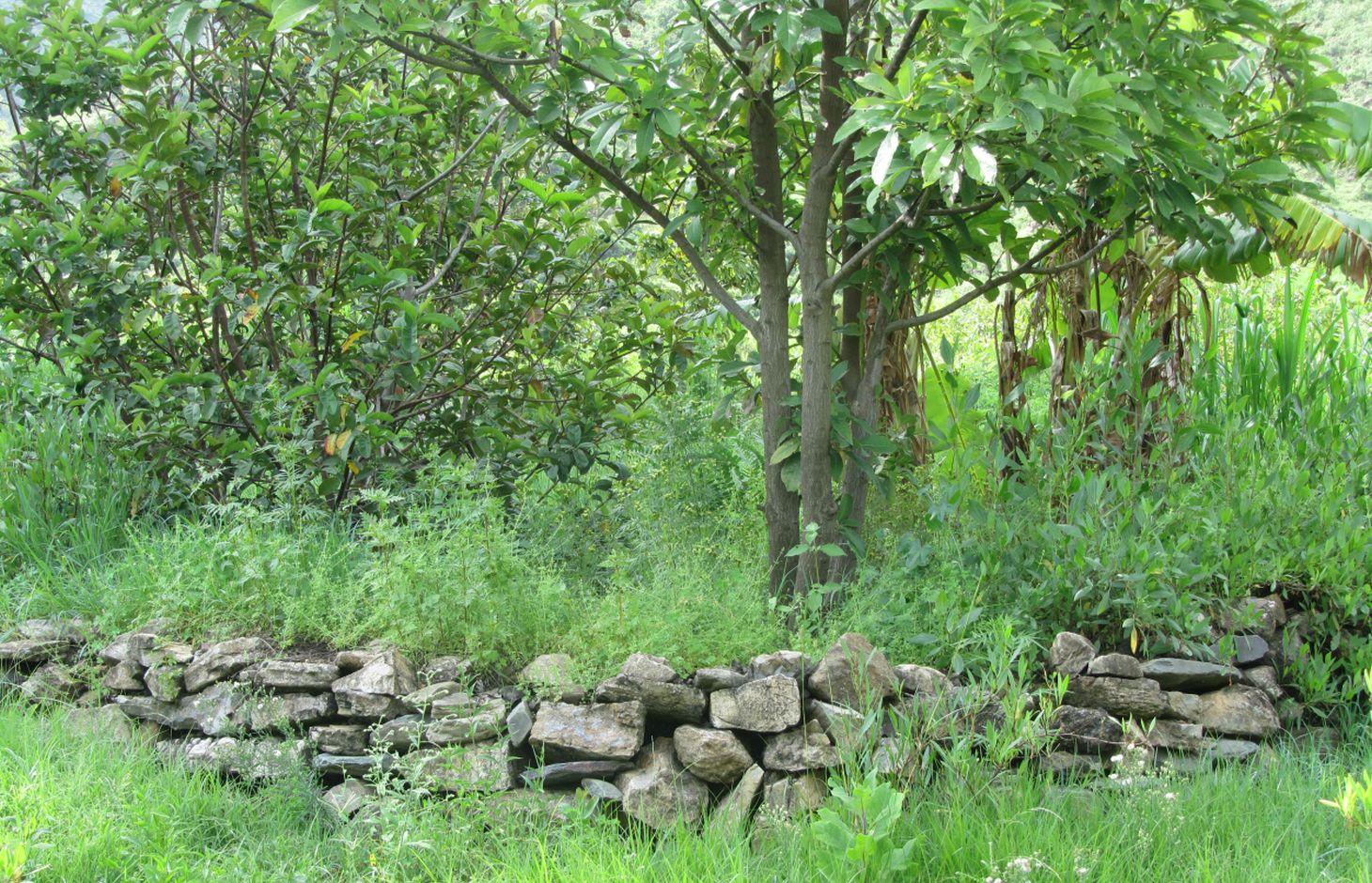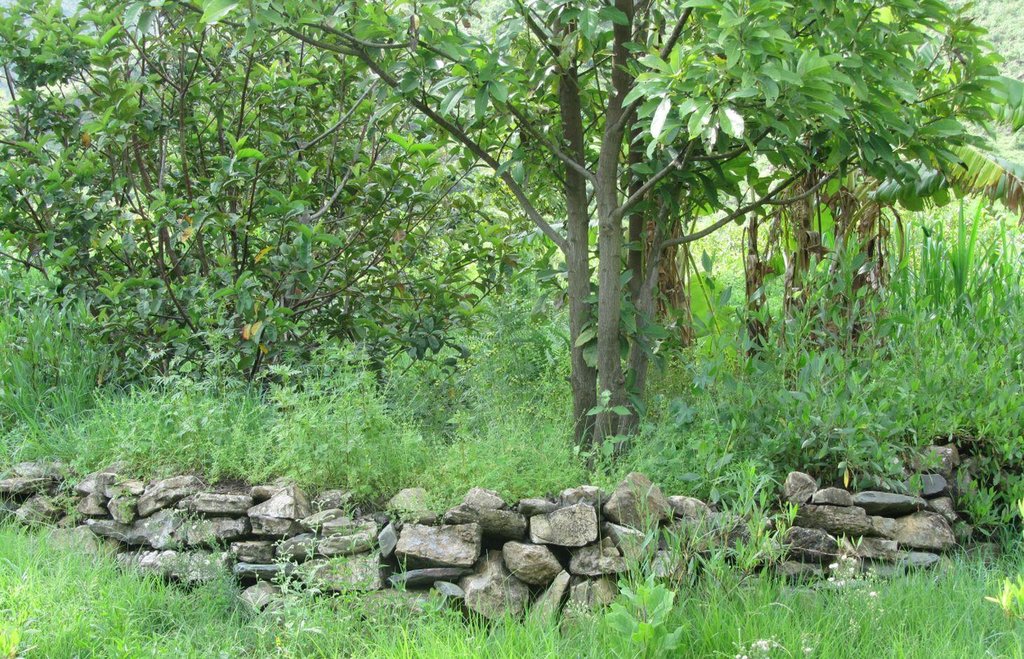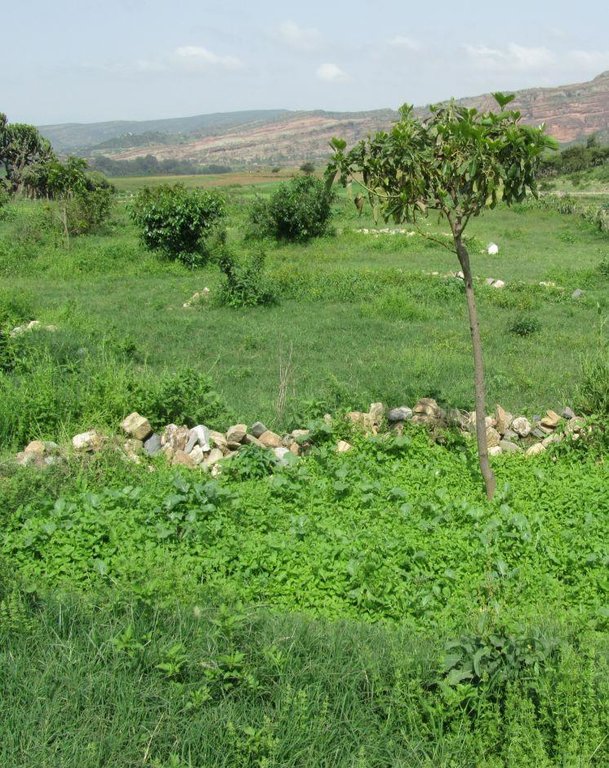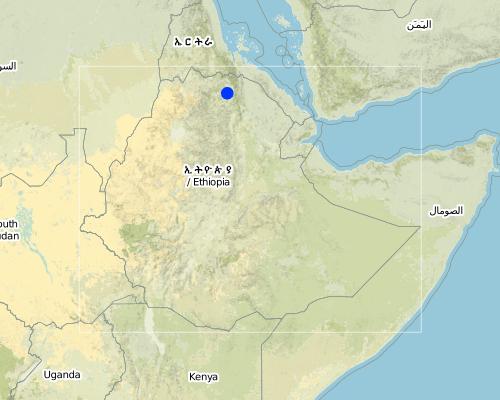Large semi circular stone bunds [Ethiopia]
- Creation:
- Update:
- Compiler: Eyasu Yazew
- Editor: –
- Reviewer: Fabian Ottiger
Abiy nay emni firki werhi
technologies_1546 - Ethiopia
View sections
Expand all Collapse all1. General information
1.2 Contact details of resource persons and institutions involved in the assessment and documentation of the Technology
SLM specialist:
Hailemariam Mengisteab
+251 910 170415
Mekelle University
P.O.Box 231, Mekelle, Ethiopia
Ethiopia
SLM specialist:
Weldearegay Kifle
+251 910 170415
Mekelle University
P.O.Box 231, Mekelle, Ethiopia
Ethiopia
Name of the institution(s) which facilitated the documentation/ evaluation of the Technology (if relevant)
Mekelle University (Mekelle University) - Ethiopia1.3 Conditions regarding the use of data documented through WOCAT
When were the data compiled (in the field)?
11/11/2012
The compiler and key resource person(s) accept the conditions regarding the use of data documented through WOCAT:
Yes
2. Description of the SLM Technology
2.1 Short description of the Technology
Definition of the Technology:
These consist of stone embankments built in the shape of a semi circle with the tips of the bund on the contour and are arranged in staggered orientation in rows so that overflow from one row will run into the next downslope.
2.2 Detailed description of the Technology
Description:
Large semi circular stone bunds are constructed by excavating a foundation of 0.1 - 0.2 m following the semi circle and building of the embankment using stones with a decreasing height at the tips to evacuate excess runoff. 1 - 3 pits are excavated within the semi circle for for planting trees.
Large semi circular stone bunds (Large half moons) are constructed with a diameter of 6 m and corresponding perimeter/length of 9.42 m. The spacing between the tips of adjacent bunds within a row and between the base bund and tip of adjacent rows is 3 m. The height of the embankment varies from 0.5 - 0.75 m at the base bund to 0.4 - 0.5 m at the tip while the corresponding width varies from 0.4 - 0.5 m to 0.2 - 0.3 m. The planting pit has a diameter and depth of 0.3 m.
Purpose of the Technology: Large semi circular stone bunds assist in decreasing slope length, runoff velocity and soil loss; and improving runoff harvesting, soil moisture and groundwater recharge.
Establishment / maintenance activities and inputs: The establishment of large semi circular stone bunds involves collection of stones, alignment of a contour and the semi circle, excavation of foundation, construction of the embankment and digging of planting pits and runoff harvesting ditch. The maintenance includes re-enforcing the embankment and dredging sediment from runoff harvesting ditch during the dry season.
Natural / human environment: Large semi circular stone bunds are implemented in foot (5 - 8%) and hill (8 - 16%) slopes and in medium and light soil types of shallow to moderate depth (0.2 - 0.8 m). It reduces runoff amount and velocity thereby decreasing soil loss and desertification/land degradation. It also improves soil moisture availability and groundwater recharge.
It is mostly constructed using communal labour and there is a moderate trend of spontaneous adoption. The technology is witnessed to be increasing fruit and fodder production thereby improving the livelihood of the land users. It, however, demands high labour especially during establishment.
2.3 Photos of the Technology
2.5 Country/ region/ locations where the Technology has been applied and which are covered by this assessment
Country:
Ethiopia
Region/ State/ Province:
Tigray
Further specification of location:
Kilte Awlaelo
Map
×2.6 Date of implementation
If precise year is not known, indicate approximate date:
- less than 10 years ago (recently)
2.7 Introduction of the Technology
Specify how the Technology was introduced:
- through projects/ external interventions
3. Classification of the SLM Technology
3.1 Main purpose(s) of the Technology
- reduce, prevent, restore land degradation
3.2 Current land use type(s) where the Technology is applied

Cropland
- Tree and shrub cropping
Main crops (cash and food crops):
Major cash crop: Fruit trees such as mango, guava, lemon.

Forest/ woodlands
Comments:
Major land use problems (compiler’s opinion): Deforestation, soil erosion, overgrazing, decline of soil fertility and productivity.
Major land use problems (land users’ perception): Decrease soil moisture, drought, soil erosion, decrease fodder production and shortage of fuel wood.
Plantation forestry: Deforestation
Forest products and services: timber, fuelwood, fruits and nuts, grazing / browsing, nature conservation / protection
3.3 Further information about land use
Water supply for the land on which the Technology is applied:
- rainfed
Number of growing seasons per year:
- 1
Specify:
Longest growing period in days: 150 Longest growing period from month to month: June - November
3.4 SLM group to which the Technology belongs
- cross-slope measure
- ground water management
3.5 Spread of the Technology
Specify the spread of the Technology:
- evenly spread over an area
If the Technology is evenly spread over an area, indicate approximate area covered:
- 10-100 km2
3.6 SLM measures comprising the Technology

structural measures
- S2: Bunds, banks
Comments:
Main measures: structural measures
3.7 Main types of land degradation addressed by the Technology

soil erosion by water
- Wt: loss of topsoil/ surface erosion
- Wg: gully erosion/ gullying
- Wo: offsite degradation effects

biological degradation
- Bc: reduction of vegetation cover
- Bs: quality and species composition/ diversity decline
Comments:
Main type of degradation addressed: Wt: loss of topsoil / surface erosion
Secondary types of degradation addressed: Wg: gully erosion / gullying, Wo: offsite degradation effects, Bc: reduction of vegetation cover, Bs: quality and species composition /diversity decline
Main causes of degradation: deforestation / removal of natural vegetation (incl. forest fires), Heavy / extreme rainfall (intensity/amounts), other natural causes (avalanches, volcanic eruptions, mud flows, highly susceptible natural resources, extreme topography, etc.) specify (Steep topography), population pressure
Secondary causes of degradation: over-exploitation of vegetation for domestic use, overgrazing, droughts, land tenure, poverty / wealth, education, access to knowledge and support services
3.8 Prevention, reduction, or restoration of land degradation
Specify the goal of the Technology with regard to land degradation:
- reduce land degradation
- restore/ rehabilitate severely degraded land
Comments:
Secondary goals: rehabilitation / reclamation of denuded land
4. Technical specifications, implementation activities, inputs, and costs
4.1 Technical drawing of the Technology
4.2 Technical specifications/ explanations of technical drawing
Large semi circular stone bunds are stone embankments built in the shape of a semi circle with the tips of the bund on the contour and are arranged in staggered orientation in rows so that overflow from one row will run into the next downslope.
Location: Tigray. Kilte Awlaelo
Date: 10/10/2014
Technical knowledge required for field staff / advisors: moderate
Technical knowledge required for land users: low
Main technical functions: control of dispersed runoff: retain / trap, reduction of slope length
Secondary technical functions: increase of infiltration, increase / maintain water stored in soil, increase of groundwater level / recharge of groundwater, sediment retention / trapping, sediment harvesting, increase of biomass (quantity)
Bund/ bank: semi-circular/V shaped trapezoidal
Vertical interval between structures (m): 0.2 - 0.3
Spacing between structures (m): 3
Depth of ditches/pits/dams (m): 1
Width of ditches/pits/dams (m): 1
Length of ditches/pits/dams (m): 1
Height of bunds/banks/others (m): 0.5 - 0.75
Width of bunds/banks/others (m): 0.4 - 0.5
Length of bunds/banks/others (m): 9.42
Construction material (stone): The embankment of the semi circular bunds is constructed by the stones.
Slope (which determines the spacing indicated above): 6.5 and 12%
Lateral gradient along the structure: 0%
4.3 General information regarding the calculation of inputs and costs
other/ national currency (specify):
Birr
Indicate exchange rate from USD to local currency (if relevant): 1 USD =:
18.0
Indicate average wage cost of hired labour per day:
2.50
4.4 Establishment activities
| Activity | Type of measure | Timing | |
|---|---|---|---|
| 1. | Collection of stones, contour and semi circle alignment, excavation of foundation, construction of bunds and excavation of planting pits and water storage ditch. | Structural | January - May |
4.5 Costs and inputs needed for establishment
| Specify input | Unit | Quantity | Costs per Unit | Total costs per input | % of costs borne by land users | |
|---|---|---|---|---|---|---|
| Labour | Labour | ha | 1.0 | 3667.0 | 3667.0 | 60.0 |
| Equipment | Tools | ha | 1.0 | 75.0 | 75.0 | |
| Total costs for establishment of the Technology | 3742.0 | |||||
Comments:
Duration of establishment phase: 24 month(s)
4.6 Maintenance/ recurrent activities
| Activity | Type of measure | Timing/ frequency | |
|---|---|---|---|
| 1. | Replacement of displaced stones and dredging of planting pits and storage ditch | Structural | January - May |
4.7 Costs and inputs needed for maintenance/ recurrent activities (per year)
| Specify input | Unit | Quantity | Costs per Unit | Total costs per input | % of costs borne by land users | |
|---|---|---|---|---|---|---|
| Labour | Labour | ha | 1.0 | 117.0 | 117.0 | 100.0 |
| Total costs for maintenance of the Technology | 117.0 | |||||
Comments:
Machinery/ tools: Line level, tape meter, digging hoe, shovel, hammer
The cost was calculated for a semi circular bund of 6 m diameter, spacing between the tips of adjacent bunds within a row of 3 m and spacing between a base bund of one row and the tip of the next row of 3 m. This arrangement results in a construction of 2.5 bunds over 94.5 square meter area and a total of 264 bunds per ha.
The construction of one large semi circular stone bund and excavation of the planting pits and runoff harvesting ditch requires 5 person days during establishment while maintaining it needs 0.2 person days.The cost calculation rates apply to 2012. Accordingly, the daily labour wage is 40 Birr for light work such as sediment dredging and 50 Birr for medium work such as stone collection.
4.8 Most important factors affecting the costs
Describe the most determinate factors affecting the costs:
Labour, slope, stone availability and size.
5. Natural and human environment
5.1 Climate
Annual rainfall
- < 250 mm
- 251-500 mm
- 501-750 mm
- 751-1,000 mm
- 1,001-1,500 mm
- 1,501-2,000 mm
- 2,001-3,000 mm
- 3,001-4,000 mm
- > 4,000 mm
Specifications/ comments on rainfall:
Average rainfall of 450-550 mm, Main rainy season from Mid-June to August
Agro-climatic zone
- semi-arid
Thermal climate class: subtropics
5.2 Topography
Slopes on average:
- flat (0-2%)
- gentle (3-5%)
- moderate (6-10%)
- rolling (11-15%)
- hilly (16-30%)
- steep (31-60%)
- very steep (>60%)
Landforms:
- plateau/plains
- ridges
- mountain slopes
- hill slopes
- footslopes
- valley floors
Altitudinal zone:
- 0-100 m a.s.l.
- 101-500 m a.s.l.
- 501-1,000 m a.s.l.
- 1,001-1,500 m a.s.l.
- 1,501-2,000 m a.s.l.
- 2,001-2,500 m a.s.l.
- 2,501-3,000 m a.s.l.
- 3,001-4,000 m a.s.l.
- > 4,000 m a.s.l.
Comments and further specifications on topography:
Slopes on average: An average slope of 6.5% is taken for moderate/foot slope and 12% for hill slope.
5.3 Soils
Soil depth on average:
- very shallow (0-20 cm)
- shallow (21-50 cm)
- moderately deep (51-80 cm)
- deep (81-120 cm)
- very deep (> 120 cm)
Soil texture (topsoil):
- coarse/ light (sandy)
- medium (loamy, silty)
Topsoil organic matter:
- low (<1%)
If available, attach full soil description or specify the available information, e.g. soil type, soil PH/ acidity, Cation Exchange Capacity, nitrogen, salinity etc.
Soil depth on average: Shallow (ranked 1) and moderately deep (Fruit tree plantation on deeper soils, ranked 2)
Soil fertility is low (medium soils, ranked 1) and very low (Light soils, ranked 2)
Soil drainage/infiltration is poor (ranked 1) and medium (ranked 2, Drainage is restricted by the soil depth)
Soil water storage capacity is medium (Medium soils, ranked 1) and low (light soils, ranked 2)
5.4 Water availability and quality
Ground water table:
5-50 m
Availability of surface water:
poor/ none
Water quality (untreated):
for agricultural use only (irrigation)
5.5 Biodiversity
Species diversity:
- low
5.6 Characteristics of land users applying the Technology
Market orientation of production system:
- subsistence (self-supply)
Off-farm income:
- less than 10% of all income
Relative level of wealth:
- poor
- average
Individuals or groups:
- groups/ community
Level of mechanization:
- manual work
Gender:
- women
- men
Indicate other relevant characteristics of the land users:
Land users applying the Technology are mainly common / average land users
Population density: 100-200 persons/km2
Annual population growth: 2% - 3%
10% of the land users are rich and own 10% of the land.
60% of the land users are average wealthy and own 55% of the land (35 Birr/day/person).
30% of the land users are poor and own 35% of the land.
5.7 Average area of land owned or leased by land users applying the Technology
- < 0.5 ha
- 0.5-1 ha
- 1-2 ha
- 2-5 ha
- 5-15 ha
- 15-50 ha
- 50-100 ha
- 100-500 ha
- 500-1,000 ha
- 1,000-10,000 ha
- > 10,000 ha
Is this considered small-, medium- or large-scale (referring to local context)?
- small-scale
Comments:
Cropland: Average land holding is 0.6 ha per household.
Forest land: Average land holding is 0.7 ha per household.
5.8 Land ownership, land use rights, and water use rights
Land ownership:
- state
Land use rights:
- communal (organized)
- individual
5.9 Access to services and infrastructure
health:
- poor
- moderate
- good
education:
- poor
- moderate
- good
technical assistance:
- poor
- moderate
- good
employment (e.g. off-farm):
- poor
- moderate
- good
markets:
- poor
- moderate
- good
energy:
- poor
- moderate
- good
roads and transport:
- poor
- moderate
- good
drinking water and sanitation:
- poor
- moderate
- good
financial services:
- poor
- moderate
- good
Mobile communication:
- poor
- moderate
- good
6. Impacts and concluding statements
6.1 On-site impacts the Technology has shown
Socio-economic impacts
Production
crop production
fodder production
animal production
production area
Income and costs
farm income
diversity of income sources
workload
Socio-cultural impacts
food security/ self-sufficiency
health situation
Comments/ specify:
Increased investment in health care as a result of increased income.
community institutions
SLM/ land degradation knowledge
situation of socially and economically disadvantaged groups
Improved livelihoods and human well-being
Ecological impacts
Water cycle/ runoff
harvesting/ collection of water
surface runoff
groundwater table/ aquifer
Soil
soil moisture
soil cover
soil loss
Biodiversity: vegetation, animals
plant diversity
6.2 Off-site impacts the Technology has shown
water availability
reliable and stable stream flows in dry season
downstream flooding
downstream siltation
6.4 Cost-benefit analysis
How do the benefits compare with the establishment costs (from land users’ perspective)?
Short-term returns:
positive
Long-term returns:
very positive
How do the benefits compare with the maintenance/ recurrent costs (from land users' perspective)?
Short-term returns:
very positive
Long-term returns:
very positive
6.5 Adoption of the Technology
If available, quantify (no. of households and/ or area covered):
2820
Of all those who have adopted the Technology, how many have did so spontaneously, i.e. without receiving any material incentives/ payments?
- 10-50%
Comments:
70% of land user families have adopted the Technology with external material support
1880 land user families have adopted the Technology with external material support
30% of land user families have adopted the Technology without any external material support
940 land user families have adopted the Technology without any external material support
There is a moderate trend towards spontaneous adoption of the Technology
6.7 Strengths/ advantages/ opportunities of the Technology
| Strengths/ advantages/ opportunities in the land user’s view |
|---|
|
Increased vegetation coverage and fruit and fodder production How can they be sustained / enhanced? Continuous maintenance of the structure. |
|
Reduced soil erosion and increased soil moisture How can they be sustained / enhanced? Continuous maintenance of the structure. |
|
Increased spring discharges downstream How can they be sustained / enhanced? Continuous maintenance of the structure. |
| Strengths/ advantages/ opportunities in the compiler’s or other key resource person’s view |
|---|
|
Decreased slope length, reduced runoff amount and velocity and soil erosion How can they be sustained / enhanced? Maintenance of bunds and runoff harvesting ditch. |
|
Increase in rainwater harvesting, soil moisture and groundwater recharge How can they be sustained / enhanced? Maintenance of bunds and runoff harvesting ditch. |
|
Increase in fruit and fodder production How can they be sustained / enhanced? Proper agronomic management |
|
Reduced maintenance requirement compared to bunds made of soils How can they be sustained / enhanced? No action needed, as is inherent to technology |
6.8 Weaknesses/ disadvantages/ risks of the Technology and ways of overcoming them
| Weaknesses/ disadvantages/ risks in the land user’s view | How can they be overcome? |
|---|---|
| Damage to structures constructed at foot slopes if the hillside is not well conserved | Conserve the upper catchment first. |
| Increase labour requirement |
Mass mobilization and/or increased incentives to households. Reducing the size of the structure. |
| Weaknesses/ disadvantages/ risks in the compiler’s or other key resource person’s view | How can they be overcome? |
|---|---|
| Poor design approach (the same diameter and spacing for different slope ranges) | Improve the design approach. |
| Increased labour demand | Mass mobilization and improving the design. |
| Reduced farm land | Increasing the spacing and reducing the dimension of bunds without compromising their effectiveness. |
7. References and links
7.2 References to available publications
Title, author, year, ISBN:
Staff members of the Kilte Awlaelo Wereda Office of Agriculture and Rural Development
Title, author, year, ISBN:
Carucci, V. (2000). Guidelines on Water Harvesting and Soil Conservation for Moisture Deficit Areas in Ethiopia:the productive use of water and soil. First draft manual for trainers, Addis Ababa, Ethiopia.
Title, author, year, ISBN:
Lakew, D., Carucci, V., Asrat, W. and Yitayew, A. (2005). Community Based Participatory Watershed Development: A guideline. Part I, first edition, Ministry of Agriculture and Rural Development, Addis Ababa, Ethiopia.
Links and modules
Expand all Collapse allLinks
No links
Modules
No modules






